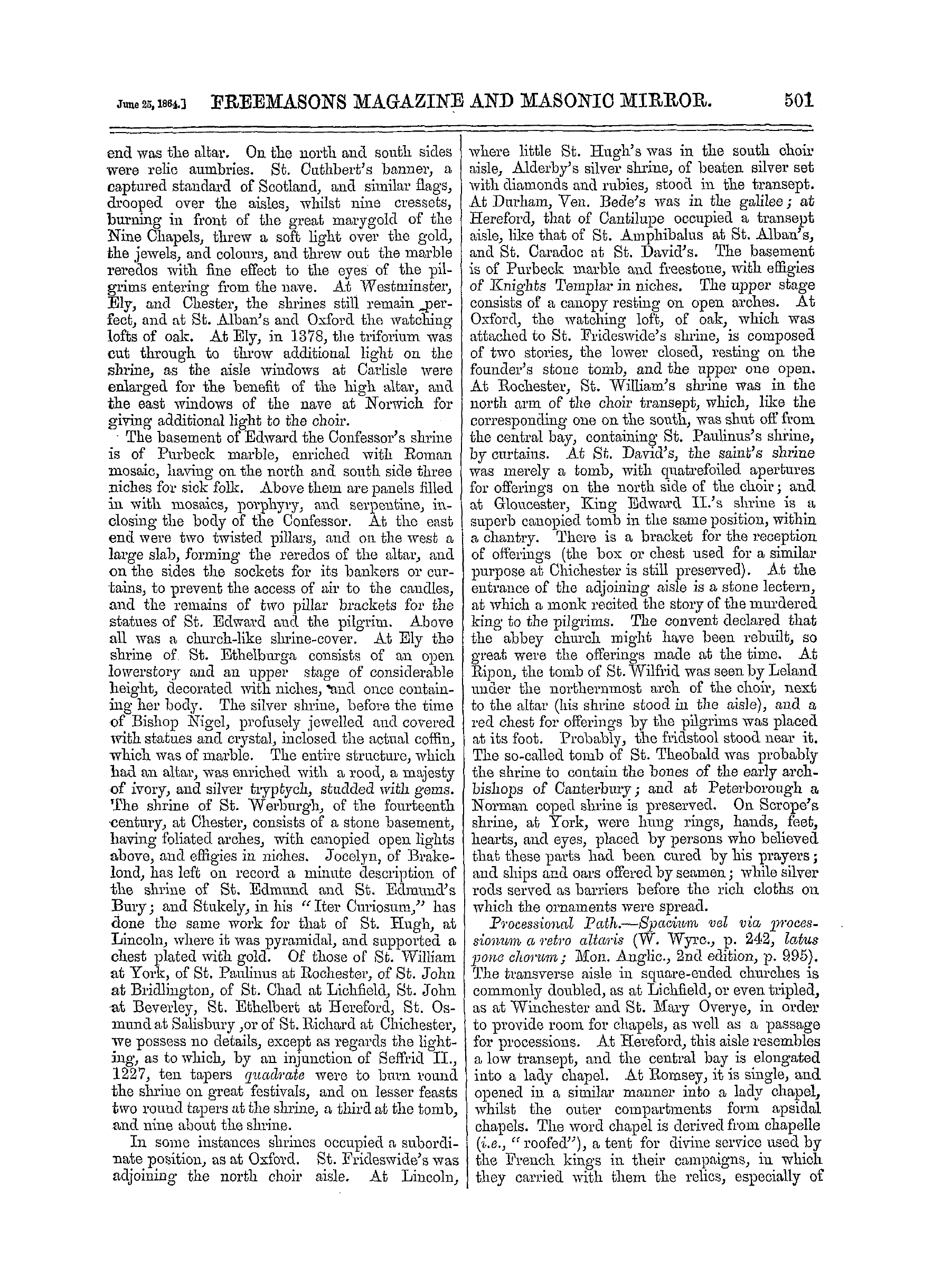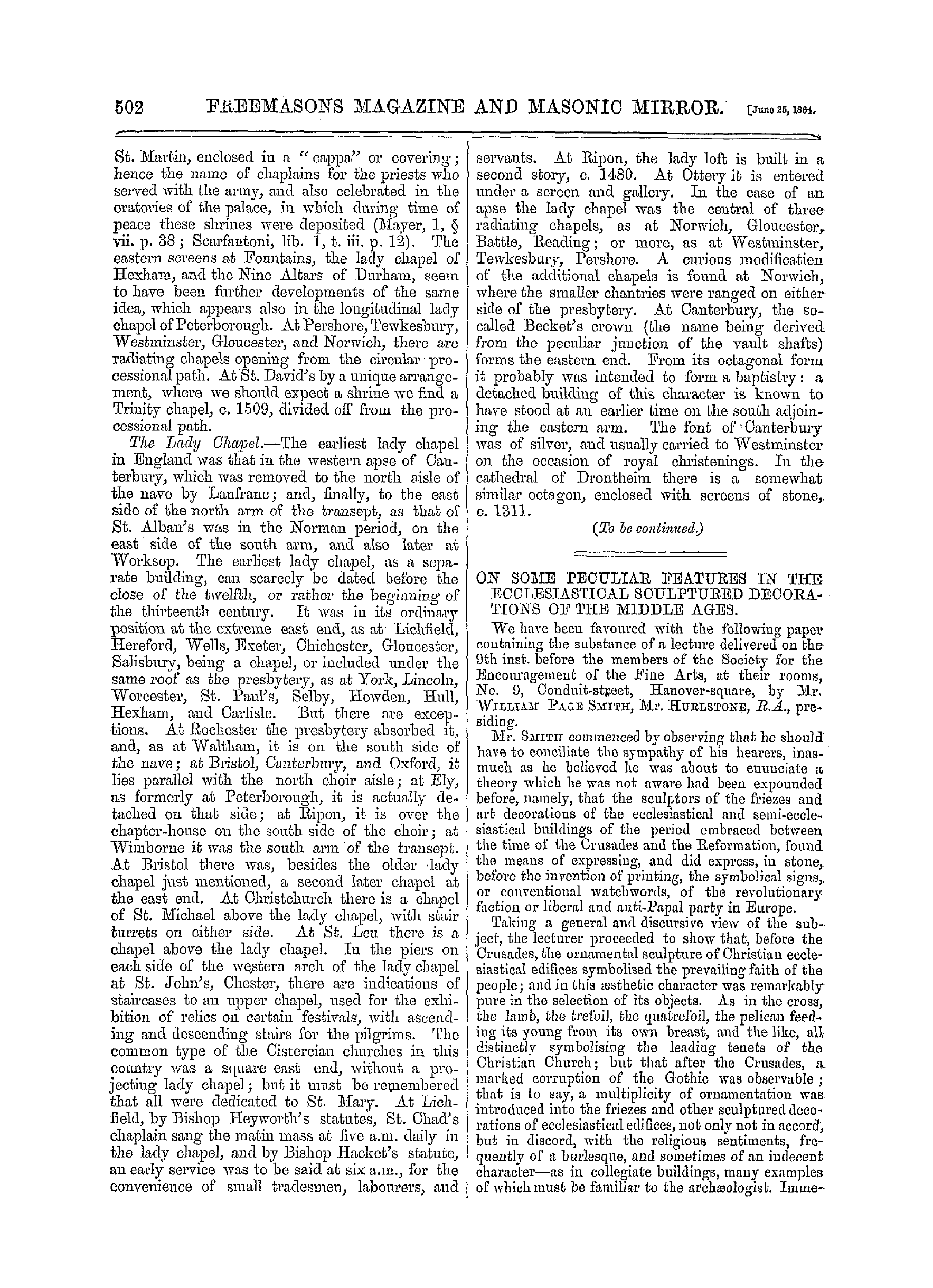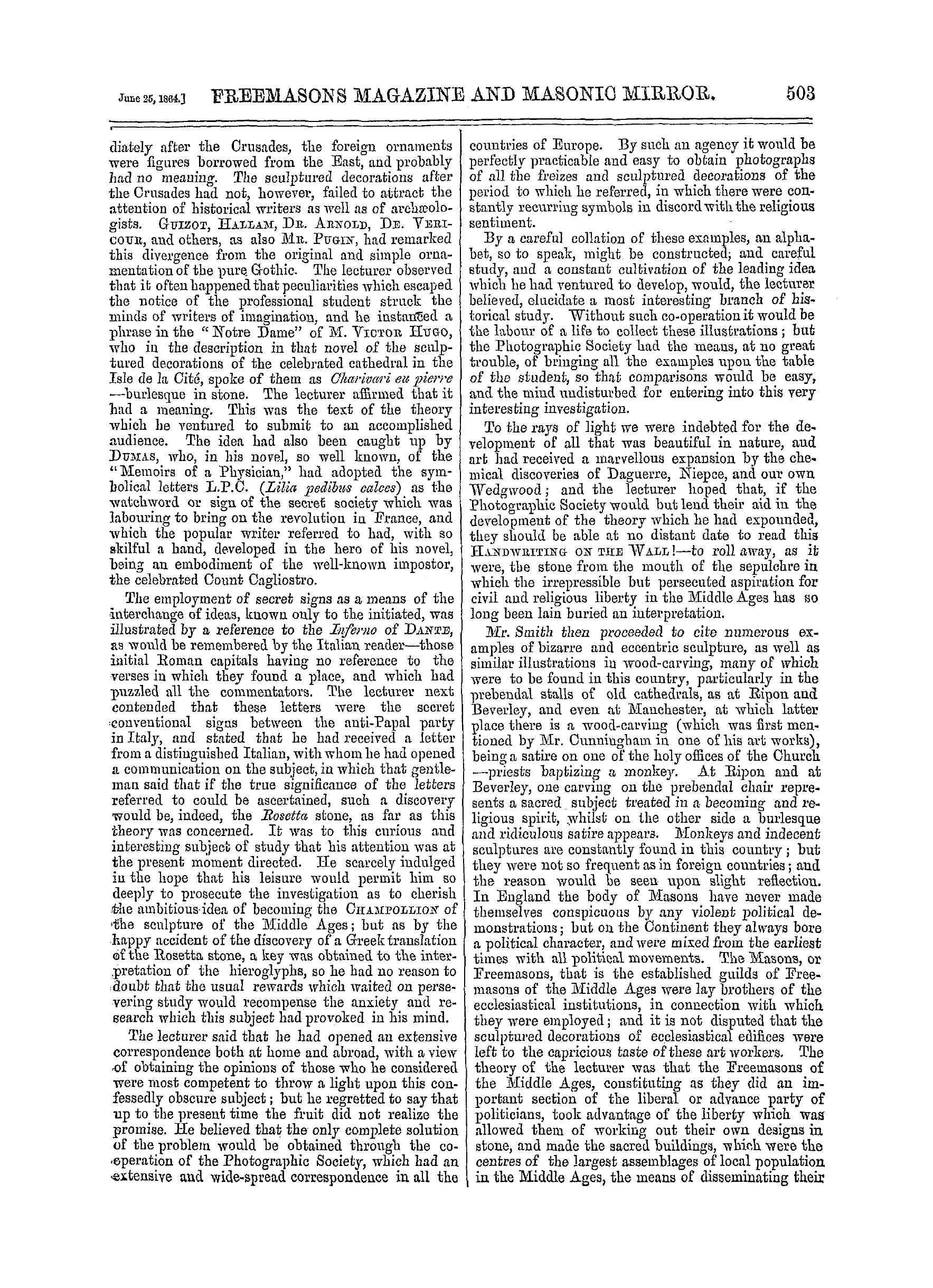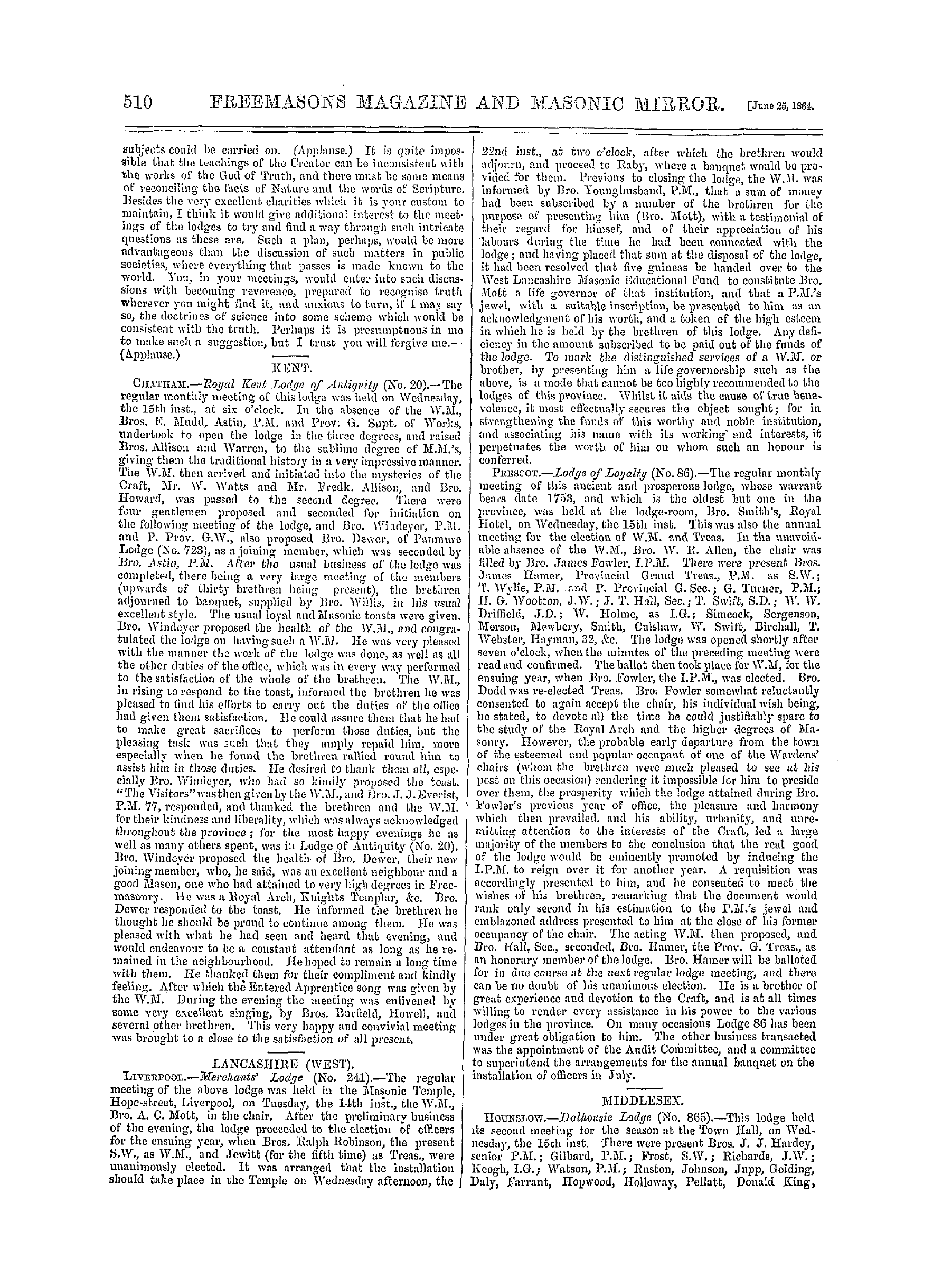Note: This text has been automatically extracted via Optical Character Recognition (OCR) software.
On Some Peculiar Features In The Ecclesiastical Sculptured Decorations Op The Middle Ages.
conventional and political signs . A monogram was enough to the initiated . It was another portion of the theory of the lecturer that this corruption of ecclesiastical decoration—this satire or burlesque in stone- — -became more marked in proportion as the corruptions of the Church of Pome developed themselves , so that a period of degradation of the priesthood
arrived when the guardians of tlie sacred edifice wero themselves not unwilling to indulge in a joke at the expense of their own Order . The Reformation sprung out of the Church of Rome itself . LTJTHEE , MELAircTHosf , Huss , ZUISGLITJS , were examples . But there was a period antecedent to this when the
liberal party were under the necessity of acting with more caution ; and the lecturer especially pointed attention to the friezes of the fourteenth century as deserving of examination . After citing many instances of the burlesque iu art , and whieh have become familiar to the traveller on the Continentas the
paint-, ings on the old wooden bridge at Lucerne , and similar examples , he contended that these were not to be regarded as the ebullitions of a capricious taste ; but as part and parcel of a design entertained by a large and intelligent class of the community to emancipate themselves from the domination of a corrupt
priesthood , by bringing its malpractices and vices into contempt through the language of painting and sculpture , which , in fact , were , at the period referred to , the only popular means of diffusing ideas . It was
for this reason that the Church availed herself so freely of symbols iu art , iu ecclesiastical vestments , in painting , and in sculpture . The cruciform disposition of the basement or ground plan of sacred edifices , was another illustration , as well as the position of the altar in Christian churches , looking to the east . Prom a summary of a vast variety of similar
illustrations , the lecturer ventured to lay clown the proposition that the general accepted aesthetic principle that the ecclesiastical architecture of a country symbolised the prevailing religious faith , was disturbed in the Middle Ages by a concurrence of peculiar influencesand that the symbols of scul pture at the
, period represented the feelings of an uprising intelligence , which ultimately found political and religious expression , in the emancipation of a large body of the Christian world , in the great historical crisis known as the Reformation ! Not being a Freemason' himself , he would not he so rude as to say that there was
no literature worthy of the name in Ereemasonry ; but he trusted there was a Preemasonry in literature which would allow him to look for the assistance of the scholars of this country , and their assistance in the development of a theory , the illustrations of whiehat the present momentwere confessedly
, , immature . He had no doubt that when the subject was fairly before the historical aud archaeological student , an immense accession of confirmatory evidence would be obtained .
A discussion ensued , in the course of which Mr . Heraud said he thought that the lecturer assumed too much when he laid down the proposition that the bizarre and eccentric sculpture to which he hacl referred was intended as a satire on the Church of Rome . He was disposed rather to regard these eccentric cities in the light of the old religious plays or moralities , which treated sacred subjects in a spirit which in our age appeared profane , but it could
On Some Peculiar Features In The Ecclesiastical Sculptured Decorations Op The Middle Ages.
scarcely he affirmed or supposed that the writers of these moralities designed to bring reli gion into contempt . Mr . LAMB , Mr . STEWAET , and other members of the society submitted some very judicious remarks upon the theory laid before the meeting , ancl the chairman having summed up , said that tlie theory
raised was undoubtedly one of great interest , hut itwas so completely novel that the committee would take time to consider the paper whieh the lecturer promised to send in , and if upon a careful consideration they thought it desirable to establish a morecomplete investigationthey would commend it
to-, the attention of the Photographic Society . A vote of thanks was then passed to Mr . Smithfor his interesting lecture , and the acknowledgments of the meeting to tbe chairman for his presidency closed the proceedings .
Antiquity Of The Third Degree.
ANTIQUITY OF THE THIRD DEGREE .
Three Lectures delivered before Lodge Industry ( No . 873 , V at Kotree , in Scindc , by Bro . W . A . BRUNTON , "W . M . LECTURE I . "A search after truth is the peculiar employment of Masonsat their periodical meetings ; and therefore they describe ifcas a Divine attribute and the foundation of every virtue . " — Axtox .
BEETIIHE : ?!—You can well understand thafc tbe questions into which I propose to enter this evening are fraught with much important interest to the Craft . Thetime has come , as has been truly remarked , when such questions should be gone into , and the answers settled on the firm basis of truth ; the cobwebs formed by credulity or vague speculation wiped away , aud the rulers
and teachers of the Craft , among whom I have the proud ! honour to rank myself an unworthy though enthusiastic member , provided with true materials for constructing our glorious symbolical temple , that when the floods of inquiry and the storms of doubt and sarcasm from without assail it , it shall not fall . And herein I must craveyour kind indulgence : so young a Master as I might
well be silent , as having much to learn . But , brethren , tho doubts which have arisen lately respecting the ; claims of our second and third degrees to antiquity , the denials of that antiquity which have been put forth from high places in Masonry , do not permit any Master of the Craft , as I humbly opine , to hold his peace altogether . It is the duty of every brother to demand a search for truth ; and if he be in a position to do so , himself to
begin to search , in however feeble a manner . So , without further preface , brethren , I will tell you the why and wherefore of this address . Yon have all heard of the good , tho learned , the great man and Mason ,. Dr . Oliver . Dr . Oliver has perhaps done more for Masom-y than any man , living or dead . He tells us himself that he has devoted the leisure hours of sixty years
to Masonry . He has been , he says , a champion for the purity of its forms and ceremonies . He has written and edited somewhere about two dozen volumes on it , all most valuable aud learned works . And he announces , finally in his last book , the Freemasons' Treasury , that in his opinion the third degree was not known in the seventeenth century , but was manufactured very early in
the eighteenth . In support of this position , he advances certain arguments which I propose in this lecture to examine ; in the next I will try to show yon some arguments on the other side ; ancl , in a third , to compare the two , and place them before you for your judgment . B refchren , —In lecture XLIV . of his last book , the learned doctor says : — " In order to ascertain the origin of the third or legendary degree in Masonry , I shall commence
Note: This text has been automatically extracted via Optical Character Recognition (OCR) software.
On Some Peculiar Features In The Ecclesiastical Sculptured Decorations Op The Middle Ages.
conventional and political signs . A monogram was enough to the initiated . It was another portion of the theory of the lecturer that this corruption of ecclesiastical decoration—this satire or burlesque in stone- — -became more marked in proportion as the corruptions of the Church of Pome developed themselves , so that a period of degradation of the priesthood
arrived when the guardians of tlie sacred edifice wero themselves not unwilling to indulge in a joke at the expense of their own Order . The Reformation sprung out of the Church of Rome itself . LTJTHEE , MELAircTHosf , Huss , ZUISGLITJS , were examples . But there was a period antecedent to this when the
liberal party were under the necessity of acting with more caution ; and the lecturer especially pointed attention to the friezes of the fourteenth century as deserving of examination . After citing many instances of the burlesque iu art , and whieh have become familiar to the traveller on the Continentas the
paint-, ings on the old wooden bridge at Lucerne , and similar examples , he contended that these were not to be regarded as the ebullitions of a capricious taste ; but as part and parcel of a design entertained by a large and intelligent class of the community to emancipate themselves from the domination of a corrupt
priesthood , by bringing its malpractices and vices into contempt through the language of painting and sculpture , which , in fact , were , at the period referred to , the only popular means of diffusing ideas . It was
for this reason that the Church availed herself so freely of symbols iu art , iu ecclesiastical vestments , in painting , and in sculpture . The cruciform disposition of the basement or ground plan of sacred edifices , was another illustration , as well as the position of the altar in Christian churches , looking to the east . Prom a summary of a vast variety of similar
illustrations , the lecturer ventured to lay clown the proposition that the general accepted aesthetic principle that the ecclesiastical architecture of a country symbolised the prevailing religious faith , was disturbed in the Middle Ages by a concurrence of peculiar influencesand that the symbols of scul pture at the
, period represented the feelings of an uprising intelligence , which ultimately found political and religious expression , in the emancipation of a large body of the Christian world , in the great historical crisis known as the Reformation ! Not being a Freemason' himself , he would not he so rude as to say that there was
no literature worthy of the name in Ereemasonry ; but he trusted there was a Preemasonry in literature which would allow him to look for the assistance of the scholars of this country , and their assistance in the development of a theory , the illustrations of whiehat the present momentwere confessedly
, , immature . He had no doubt that when the subject was fairly before the historical aud archaeological student , an immense accession of confirmatory evidence would be obtained .
A discussion ensued , in the course of which Mr . Heraud said he thought that the lecturer assumed too much when he laid down the proposition that the bizarre and eccentric sculpture to which he hacl referred was intended as a satire on the Church of Rome . He was disposed rather to regard these eccentric cities in the light of the old religious plays or moralities , which treated sacred subjects in a spirit which in our age appeared profane , but it could
On Some Peculiar Features In The Ecclesiastical Sculptured Decorations Op The Middle Ages.
scarcely he affirmed or supposed that the writers of these moralities designed to bring reli gion into contempt . Mr . LAMB , Mr . STEWAET , and other members of the society submitted some very judicious remarks upon the theory laid before the meeting , ancl the chairman having summed up , said that tlie theory
raised was undoubtedly one of great interest , hut itwas so completely novel that the committee would take time to consider the paper whieh the lecturer promised to send in , and if upon a careful consideration they thought it desirable to establish a morecomplete investigationthey would commend it
to-, the attention of the Photographic Society . A vote of thanks was then passed to Mr . Smithfor his interesting lecture , and the acknowledgments of the meeting to tbe chairman for his presidency closed the proceedings .
Antiquity Of The Third Degree.
ANTIQUITY OF THE THIRD DEGREE .
Three Lectures delivered before Lodge Industry ( No . 873 , V at Kotree , in Scindc , by Bro . W . A . BRUNTON , "W . M . LECTURE I . "A search after truth is the peculiar employment of Masonsat their periodical meetings ; and therefore they describe ifcas a Divine attribute and the foundation of every virtue . " — Axtox .
BEETIIHE : ?!—You can well understand thafc tbe questions into which I propose to enter this evening are fraught with much important interest to the Craft . Thetime has come , as has been truly remarked , when such questions should be gone into , and the answers settled on the firm basis of truth ; the cobwebs formed by credulity or vague speculation wiped away , aud the rulers
and teachers of the Craft , among whom I have the proud ! honour to rank myself an unworthy though enthusiastic member , provided with true materials for constructing our glorious symbolical temple , that when the floods of inquiry and the storms of doubt and sarcasm from without assail it , it shall not fall . And herein I must craveyour kind indulgence : so young a Master as I might
well be silent , as having much to learn . But , brethren , tho doubts which have arisen lately respecting the ; claims of our second and third degrees to antiquity , the denials of that antiquity which have been put forth from high places in Masonry , do not permit any Master of the Craft , as I humbly opine , to hold his peace altogether . It is the duty of every brother to demand a search for truth ; and if he be in a position to do so , himself to
begin to search , in however feeble a manner . So , without further preface , brethren , I will tell you the why and wherefore of this address . Yon have all heard of the good , tho learned , the great man and Mason ,. Dr . Oliver . Dr . Oliver has perhaps done more for Masom-y than any man , living or dead . He tells us himself that he has devoted the leisure hours of sixty years
to Masonry . He has been , he says , a champion for the purity of its forms and ceremonies . He has written and edited somewhere about two dozen volumes on it , all most valuable aud learned works . And he announces , finally in his last book , the Freemasons' Treasury , that in his opinion the third degree was not known in the seventeenth century , but was manufactured very early in
the eighteenth . In support of this position , he advances certain arguments which I propose in this lecture to examine ; in the next I will try to show yon some arguments on the other side ; ancl , in a third , to compare the two , and place them before you for your judgment . B refchren , —In lecture XLIV . of his last book , the learned doctor says : — " In order to ascertain the origin of the third or legendary degree in Masonry , I shall commence



















